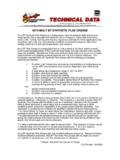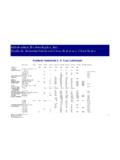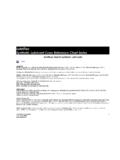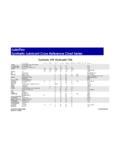Transcription of Recommended methods for the Identification and …
1 Manual for use by national drug analysis laboratoriesRecommended methods for the Identification and Analysis of synthetic Cannabinoid Receptor Agonists in Seized MaterialsPhoto credits:University Medical Center Freiburg, GermanyLaboratory and Scientific Section UNODCL aboratory and Scientific SectionUnited nationS office on drUgS and crimeViennaRecommended methods for the Identification and Analysis of synthetic Cannabinoid Receptor Agonists in Seized MaterialsMANUAL FOR USE BY NATIONAL DRUG ANALYSIS LABORATORIESUNITED NATIONSNew York, 2013iiNoteOperating and experimental conditions are reproduced from the original reference materials, including unpublished methods , validated and used in selected national laboratories as per the list of references.
2 A number of alternative conditions and substitution of named commercial products may provide comparable results in many cases, but any modification has to be validated before it is integrated into laboratory of names of firms and commercial products does not imply the endorsement of the United language: English United Nations, May 2013. All rights reserved, worldwideThe designations employed and the presentation of material in this publication do not imply the expression of any opinion whatsoever on the part of the Secretariat of the United Nations concerning the legal status of any country, territory, city or area, or of its authorities, or concerning the delimitation of its frontiers or boundaries. This publication has not been formally production: English, Publishing and Library Section, United Nations Office at s Laboratory and Scientific Section (LSS, headed by Dr.)
3 Justice Tettey) wishes to express its appreciation and thanks to Dr. Volker Auw rter of the Univer-sity Medical Center Freiburg, Germany and Mr. Michael P tz of the Federal Crim-inal Police Office (BKA), Germany for the preparation of the final draft of the present Manual. LSS would also like to thank the following experts for their contribution of analytical methods from their respective laboratories:Dr. Jan Sch per and Dr. Marc Wende of the Bavarian State Office of Criminal Investigation (BLKA), Germany; Mr. Christoph H rtel and Mr. Thorsten R ssler of the Federal Criminal Police Office (BKA), Germany; Mr. Bj rn Moosmann and Mr. Stefan Kneisel of the University Medical Center Freiburg, Germany; and Prof. Veniero Gambaro and Dr.
4 Gabriella Roda of the University of Milan, valuable comments and contribution of the following experts to the peer-review process is gratefully acknowledged:Dr. Laurence Dujourdy of the Institut National de Police Scientifique, France; Dr. Jenny Rosengren Holmberg of the National Laboratory of Forensic Science, Sweden; Ms. Ulla-Maija Laakkonen of the National Bureau of Investigation, Finland; Ms. Emma Tiainen of the Finnish Customs Laboratory, Finland; Dr. Folker Westphal of the State Bureau of Criminal Investigation (Landeskriminalamt), Germany and Dr. Dariusz Zuba of the Institute of Forensic Research, preparation of the present Manual was coordinated by Ms. Yen Ling Wong, staff of LSS. The contribution of other UNODC staff is gratefully Introduction.
5 Background .. Purpose and use of the Manual .. 22. General aspects .. Definition of synthetic cannabinoids .. Chemical classification .. Products and modes of administration .. 63. Description of the pure compounds .. Classical cannabinoids .. Non-classical cannabinoids .. Hybrid cannabinoids .. Aminoalkylindoles .. Eicosanoids .. Others .. 174. Production and diversion .. Synthesis of pure compounds .. Production of herbal preparations .. Precursors and sources .. Typical seized materials .. Adulterants/masking agents .. 215. Qualitative and quantitative analysis of materials containing synthetic cannabinoids .. General aspects .. Sampling.
6 Extraction and sample preparation .. Analysis of synthetic cannabinoids .. 26 Presumptive tests .. 26 Thin-layer chromatography (TLC) .. 26 Ion mobility spectrometry (IMS) .. 31 Gas chromatography-mass spectrometry (GC-MS) .. 33 Gas chromatography (GC) with flame ionization detection (GC-FID) .. 36 Ultra high performance liquid chromatography (UHPLC) .. 38 Liquid chromatography-tandem mass spectrometry (LC-MS/MS) .. 42vi6. Additional analytical techniques for the analysis of synthetic cannabinoids Infrared spectroscopy (ATR-IR and FTIR) .. Gas chromatography-infrared detection (GC-IRD) .. Ambient ionization mass spectrometry .. High resolution mass spectrometry (HRMS).
7 Matrix assisted laser desorption ionization-time of flight mass spectrometry (MALDI-TOF-MS) .. Nuclear magnetic resonance (NMR) spectroscopy .. 507. Isolation and chemical characterization of new synthetic cannabinoids .. 518. References .. 5311. BackgroundIn 2008, several synthetic cannabinoid receptor agonists (referred to as synthetic cannabinoids throughout the rest of this document) were detected in herbal smoking blends which were sold on the Internet and in specialized shops under a variety of brand names such as Spice Silver , Spice Gold , Spice Diamond , Yucatan Fire and Smoke [1, 2]. These colourful and professionally designed packages of herbal products typically contain about grams of finely cut plant material to which one or more synthetic cannabinoids have been added [3, 4].
8 Generally, they do not contain cannabis but produce cannabis-like effects. Furthermore, they are usually administered by smoking, either as a joint or in a water 2008, the use of these herbal products seemed to be restricted to a small number of experimental users. However, in 2008, these products achieved immense popularity in Germany and other European countries through the Internet and in subsequent media reports, where they were referred to as legal alternatives to cannabis, thus unintentionally promoting the use of these drugs. Since then, hundreds of new herbal products with different brand names have been marketed. The syn-thetic additives in these products could vary significantly in terms of quantity as well as the types of synthetic cannabinoids used [2, 3, 5-19].
9 Although so far, relatively little is known about the pharmacology and toxicology of the various (frequently changing) synthetic cannabinoids that are added to the herbal products, a number of these substances may have a higher addictive potential compared to cannabis due to quicker development of tolerance and could exhibit a tendency towards higher acute and long-term , none of the synthetic cannabinoids found in these herbal products are internationally controlled by the 1961 Single Convention on Narcotic Drugs or by the 1971 Convention on Psychotropic Substances. Moreover, the control status of these compounds differs significantly from country to country. Most countries are challenged by the sheer number of synthetic cannabinoids constantly emerging, which means that control measures targeting individual compounds can be easily 2 Recommended methods for the Identification and analysis of synthetic cannabinoid receptor agonistscircumnavigated.
10 At the time of publication, some Member States, for example, Austria, Ireland, Luxembourg, Switzerland and United Kingdom, have adopted a more generic approach to controlling synthetic cannabinoids of similar structures. Nevertheless, effective implementation of control measures could be hampered by the lack of analytical data and reference Purpose and use of the ManualThe present Manual is one in a series of similar publications dealing with the iden-tification and analysis of various types of drugs under control. These manuals are the outcome of a programme pursued by UNODC since the early 1980s, aimed at the harmonization and establishment of Recommended methods of analysis for national drug analysis line with the overall objective of the series, the present Manual suggests approaches that may assist drug analysts in the selection of methods appropriate to the sample under examination and provide data suitable for the purpose at hand, leaving room also for adaptation to the level of sophistication of different laboratories and the various legal needs.















